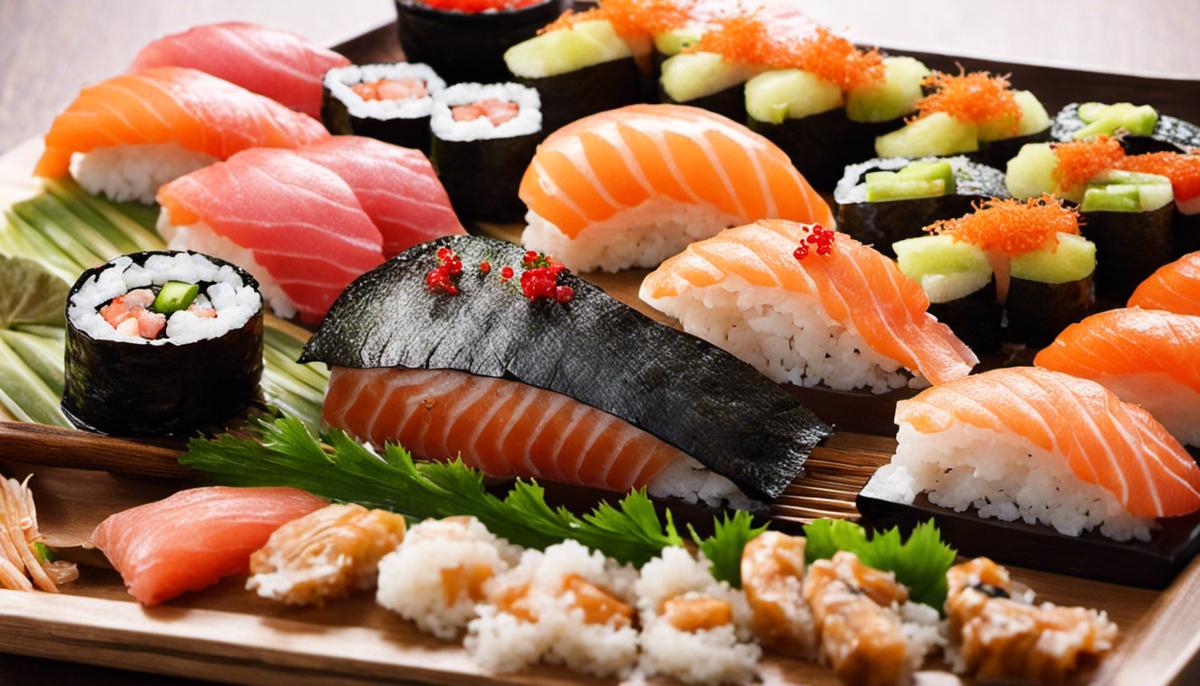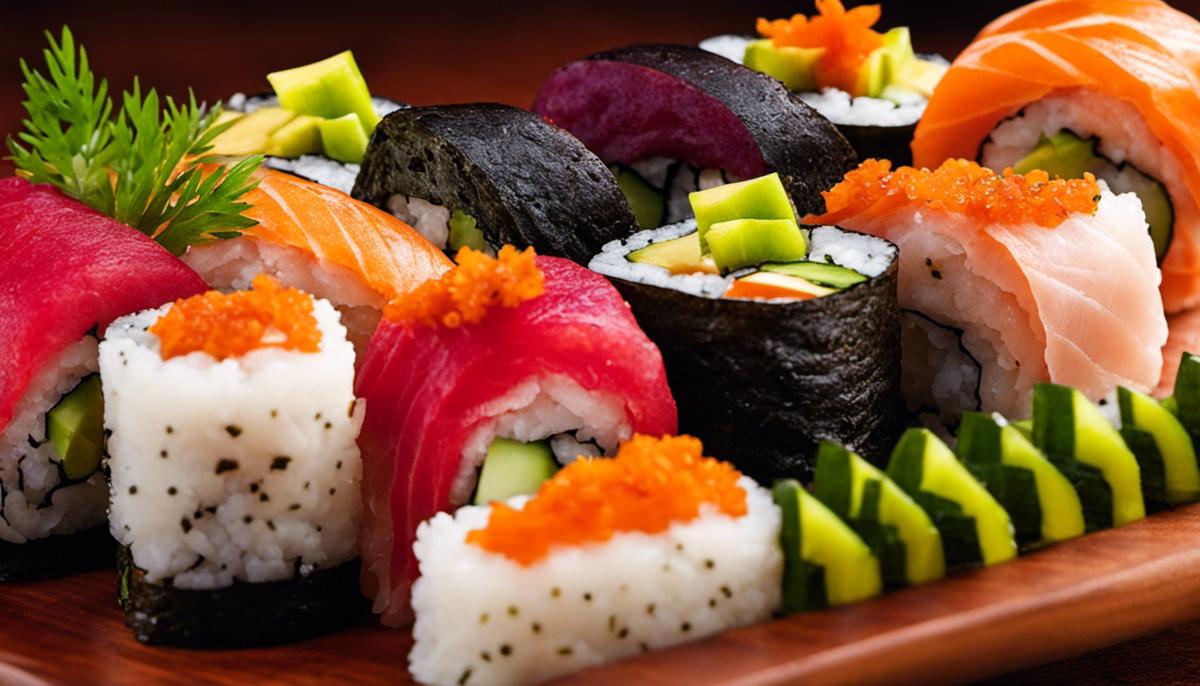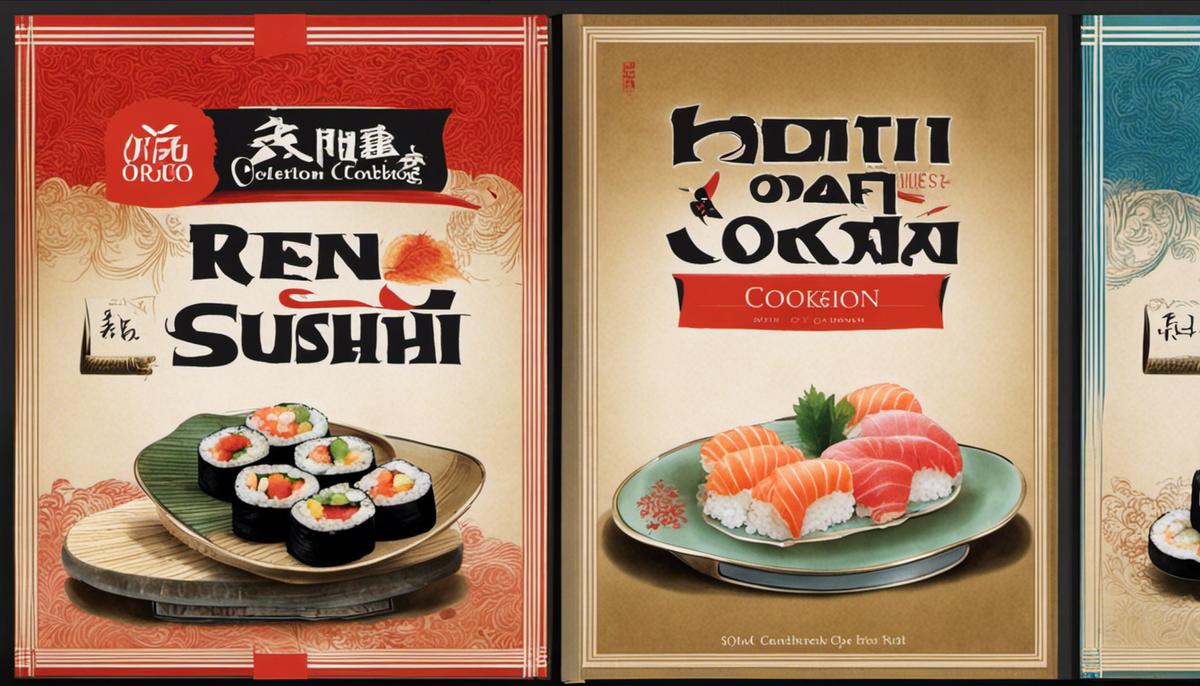The world of sushi is more than just a simple dish – it is a symbol of art, culture and culinary delights. With the donning of the traditional kimono, the athletic dance of sashimi cutting and the careful arrangement on the ceramic plate, the preparation of sushi is a celebratory moment that enchants people from all cultures and generations. In this essay, we’ll dive into the deep-rooted history of sushi, its rise to global popularity, and look at the craft process behind making sushi. Finally, we present a curated list of the best sushi cookbooks for every sushi lover.
The History of Sushi
The origins of sushi are impressively old, dating back thousands of years to the 4th century BC. Like many good things, sushi was born out of necessity – as a method of preserving raw fish by fermenting it with rice. It wasn’t until many years later that this delicious meal was even elevated to an art form.
The first form was called “Narezushi” and came from Southeast Asia. Fish was stored in acidified rice to delay natural decay. The result? A fish that could be kept for months and could be taken with you on your travels or eaten later. It is noteworthy that the rice was usually discarded and only the fermented fish was consumed.
Over the centuries, Narezushi continued to evolve and spread within Japan. In the Edo period, a period of great innovation, art and cuisine crowned themselves in the heart of Tokyo. “Hayazushi” was born and rice no longer became a waste product. Instead of fermented fish, freshly caught fish was now used and served together with the rice. This is probably the original recipe for what we know as sushi today.
With their love of beauty and perfection, the Japanese strove to make these dishes as aesthetically pleasing as possible. “Nigiri Sushi” was invented in the 19th century by the talented chef Hanaya Yohei, who decorated small bites of rice with fresh fish.
In the mid-20th century, after World War II, the clever Ichiro Mashita invented the “California Roll.” By substituting tuna with avocado and crab meat, he made sushi more accessible to the Western palate.
Today, sushi is an internationally popular dish that stands out for its clean flavors, healthy ingredients, and the artistry with which it is presented. Whether in chic restaurants in the world’s major capitals or in little hidden gems that rely on more traditional recipes and techniques, sushi has conquered the world and remains an unmistakable symbol of both culinary enjoyment and subtle aesthetics. And just as our tastes evolve, so does sushi and captivates us again and again.

Sushi preparation and presentation
Sushi is not just a dish, it is a true art form that requires a lot of skill and attention to detail.
In the preparation of sushi, there are some key elements that decisively influence the result. One of these key components is, of course, the fish. A high quality of fish is essential for good sushi. The most famous is the bluefin tuna, which is used in the best sushi restaurants in the world. But salmon, red snapper or sole are also used. When choosing fish, attention should be paid not only to freshness, but also to sustainability.
Equally important is the rice. Sushi rice differs from typical rice in its texture and taste. It’s short-grained and sticky, allowing it to hold together when formed. It’s seasoned with rice vinegar, which gives it its characteristic slightly sweet and sour flavor. Quality sushi rice can often be a distinguishing factor for a superior sushi.
Next, consider the other ingredients. They are an opportunity for the skilled sushi chef to demonstrate his ability to balance and compliment flavors. Common ingredients include egg omelet, cucumber, avocado, and even cooked crab. A true sushi master knows how to select and pair these ingredients to let the flavors of each complement the others.
The presentation is another decisive factor, because as with all things in life, the eye eats with you.
In the presentation of sushi, the devotion to aesthetics is evident. The colors are bold with the raw, juicy fish fillets, glossy white rice, light green avocado pieces, and dark seaweed leaves. The pieces are symmetrical and precisely shaped and arranged on a plate or wooden plank in such a way that they create an appealing, harmonious overall picture.
Now to the technology. The key to good sushi lies in the right craft technique. From the right way to fillet fish to the perfect way to shape a sushi roll, these are skills that are often passed down through generations. A good sushi chef is always a student who is constantly working to refine his art.
Whether you’re creating or enjoying sushi, recognize the passion and dedication that goes into each piece. Understand that in every bite there is centuries-old tradition, carefully selected craftsmanship and dedicated aesthetics. Love every reel, nigiri, maki, and sashimi. Because that’s what makes sushi such a unique and special dish. It’s not just about taste – it’s about experience, attention to detail, creativity and skill.

The Best Sushi Cookbooks
When it comes to an unforgettable dining experience, few dishes manage to get past the excellent fusion of flavors and craftsmanship of high-quality sushi. What was once an easy way to preserve raw fish has now become an admired art form thanks to creative chefs and unstoppable innovation in the culinary world. But to understand this world in all its depth and diversity, you need more than just a sharp palate. For this reason, we would like to present a selection of exceptional books that not only offer innovative recipes, but also provide fascinating insights into the culture and history of sushi.
The first thing you notice about sushi is the quality of the fish. The books “The Sushi Chef: Sukiyabashi Jiro” and “Sushi: Taste and Techniques” are dedicated to choosing the right fish. Here is an explanation of what to look out for when buying and how sustainability plays a role. The importance of seasonal ingredients is not overlooked, which further increase the freshness and variety of flavors of the sushi.
Rice, the inconspicuous but indispensable ingredient in every sushi, also gets a detailed treatment in “Sushi Mastery: Secrets from the best sushi chefs”. It reveals the role of rice in terms of taste and texture, as well as the secret to the perfect sushi rice.
In addition, a variety of stunning sushi recipes can be found in these books. From traditional roles to creative interpretations, there’s something for everyone. In-depth explanations of each ingredient guarantee that you’ll not only be cooking great recipes, but you’ll also understand why these combinations work so well.
As we all know, the eye eats with you, especially with a dish that is as aesthetically focused as sushi. “The Art of Sushi” reveals the many ways in which sushi can be presented and initiates the reader into the intricacies of presentation and arrangement that make each sushi dish a work of art.
Ultimately, whether you’re a budding sushi chef or just want to expand your knowledge, it’s important to remember that the art of sushi is more than just good taste. It’s about mastering a technique, the constant refinement, and the pursuit of perfection that goes into every piece of sushi. With the books presented here, you can take a step further into the fascinating world of sushi and on your way to true sushi hobby.

The jewel of Japanese cuisine, sushi, has changed the course of gastronomy. At the same time, it is still firmly anchored in its rich history and culture. Due to its diversity and adaptability, sushi is now more than just a food – it is a passion, a profession and a way of life. Whether you’re a seasoned sushi connoisseur or a curious beginner, the magic of sushi can captivate anyone. That’s why we invite you to embark on this path of culinary creativity with the recommended sushi cookbooks that stand out from the crowd. Let yourself be infected by the fascination of sushi and transform your kitchen into a thriving stage for this art form of gastronomy.


